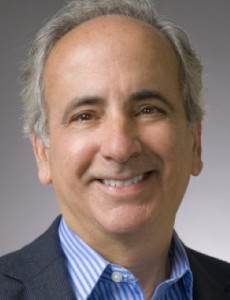Continuous Creation of New Customer Value
What does an innovative enterprise look like? Steve Denning and I recently discussed this question. He asked, what is the right organizational image that communicates the fundamental ingredients required for innovative success? Consider the figure shown, which is my version of our collaborative efforts.
See also the post, Improving Innovative Performance.
Customer focus: Customers and their market ecosystem, to the right, are the focus of all efforts. As Peter Drucker pointed out, “Because the purpose of business is to create a customer, the business enterprise has two – and only two – basic functions: marketing and innovation. Marketing and innovation produce results; all the rest are costs. Marketing is the distinguishing, unique function of the business.” If should be obvious, but too few enterprises are actively focused on their customers.
PoI Playbook: At the center of the figure is the PoI Playbook (Practice of Innovation Playbook). The PoI Playbook describes the concepts, frameworks, and processes required to systematically create high-value, disruptive innovations.
As pointed out in the Toyota Handbook,
“Whenever something – anything – is to be produced, there must be rules, or a systemized method of producing it. Whether or not the people who do the actual production fully understand those rules, that system has a deciding effect on product quality, cost, safety, and all essential determinants of success or failure.”
Successful innovation is not the result of luck or a lone genius. Rather it is a systematic process of learning, searching, and creating new knowledge, as described in our book, Innovation: The Five Disciplines for Creating What Customers Want.
In an exponentially improving world, if your innovation processes result in linear improvements, you are falling behind exponentially. The PoI Playbook is designed to produce exponential rates of improvement.
Depending on the enterprise’s business model, different playbooks are needed. For example for assuring high-quality and low-cost products, a version of TQM is required. For rapid co-creation of solutions with customers, Agile is excellent. The PoI Playbook is for the systematic creation of new, high-value innovations. Without the PoI Playbook interactions with customers, partners, and staff would be ad hoc and inefficient. Very few companies or government agencies have an effective playbook, which explains much of their poor performance.
Continuous feedback: Leadership and the innovation team, including outside partners, address customer’s important needs based on feedback between all participants. Intense, continuous feedback is the only way to obtain the customer, market, technology, and other knowledge needed to remain competitive. This image is meant to include the ideas of open innovation, application developers, and other partnerships in the enterprise’s ecosystem. Intense team iteration means not just giving a seminar every year, like at a university, but rather weekly or daily iterations. When starting new innovations iterations many need to be hourly.
Role of leadership: The slider-bar on the left indicates that leadership’s role depends on the enterprise’s business model, competitive position, and current imperatives. The position of the slider-bar represents the “sweet spot” for leadership and management. In every business a major issue is finding the right combination of top-down and bottom-up innovative leadership. Here the sweet spot is elongated to represent that, depending on the task, leadership must play different roles.
Once, while talking to Tom Friedman of the NYTs, I quipped that in the global innovation economy all top-down was fast but dumb and all bottom-up was smart but chaotic. Because innovative progress today is often at rapid exponential rates, for most companies the sweet-spot for innovative management has moved down; not up. Companies need to be closer to rapidly changing customer needs, markets, technologies, and competitors.
Friedman dubbed this Carlson’s Law and wrote about it in his last book and here. The inability to get this right means that in many companies that are too hierarchical, much of the enterprise’s collective IQ is trapped at the bottom.
Different sweet spots: The management sweet spot, from controlling to empowering, moves up and down over time as the enterprise adapts to its market and depending on the tasks being performed. Consider, for example, when Lou Gerstner took over a failing IBM in 1993. He had to make major changes from the top but, over time, those responsibilities were distributed throughout IBM.
In new company startups, management and the team are effectively one. The top-down, bottom-up issue should be almost irrelevant. If it is not, something bad is going on that needs to be fixed.

At SRI International, where I was CEO for 16 years, the business model was to build a diversified portfolio of high-value innovations. There were always 10 to 30 major new innovations underway, which were run in the manner suggested by the figure.
Application to teams and enterprises: The model shown can be used for an entire enterprise or parts of it. It was first developed at the Sarnoff Corporation with a great partner, Norman Winarsky, when we were technical directors running relatively small parts of the company. It evolved out of our study of innovation best practices from around the world. We studied every idea we could find and then tried out the best with our teams. Most of the ideas proposed did not work. They were often intellectually important but they didn’t help working professionals move forward. We keep the best ideas and developed many new practices. Only a few fundamental ideas, as described in the PoI Playbook, rapidly accelerate progress. The model we developed proved to be so successful that eventually we became responsible for most of Sarnoff and, after I became SRI’s CEO in 1998, the model was deployed across all of SRI.
Over the years many other colleagues and innovation thought leaders added ideas. My colleague and partner, Len Polizzotto, was particularly influential as was my colleague William Wilmot, who co-authored with me Innovation: The Five Disciplines for Creating What Customers Want.
Collective genius: At SRI it is understood that the static, hierarchical organization of people and projects, which is seen at many national and corporate R&D laboratories, is unproductive. It does not leverage the collective genius of the enterprise. Great ideas come from all parts of SRI, and the structures and processes of the PoI Playbook make access to those ideas inevitable. It focuses everyone on the customer and it provides the value-creation framework for creating major new innovations.

Your tests: As a first test, if your middle-level managers cannot succinctly describe the company’s innovation process, there is none. As a second test, if your innovation architecture does not “guarantee” systematic success, it is not good enough. Admonishing people to be more creative does not work – it makes the best professionals frustrated and angry. Again, although the figure highlights some main attributes, the right leadership sweet-spot for your team or company depends on your customers, business model, and place in the market ecosystem.
New roles: At SRI we constantly worked to push the management sweet spot down into the technical organizations to get the best ideas and to find the most committed, talented, and passionate colleagues. But this didn’t mean management went away — it had to assume different roles and responsibilities. For example, I was mostly a junior team-member on our innovation teams because I was rarely the technology or market expert. In effect I was “reporting” to the lead project champion who had that knowledge. My job was to help develop the value proposition, open the right doors, and get needed resources.
Sometimes the slider bar went to the top of the organization when only I could do what was needed, such as meeting high-level customers or partners. Our focus on the customer meant we were constantly assembling the best possible teams from both inside and outside SRI. Leadership must help facilitate that too.

Value-creation champion: As CEO, one of my most important roles was as the champion for SRI’s value-creation process, as outlined in the figure. If senior management is not enthusiast, engaged, and committed to the enterprise’s innovation methodology, output suffers.
When creating new ventures, like with the formation of Siri, we executed this way from the start. We had the advantage that my partner in developing this model at the Sarnoff Corporation, Norman Winarsky, came out from Princeton, N.J. to run our new ventures organization in Menlo Park, CA, which he describes with Henry Kressel in their excellent new book, If You Really Want to Change the World.
But running a 2,300-person organization this way, especially one that had been previously in slow decline for 20 years, was initially very hard. The staff was superb but these ideas were foreign. It took five years before the model took hold and SRI became recognized as one of the world’s most successful innovation enterprises.
New companies, like Uber, have the advantage of operating like this from the start. They are completely customer focused and the services they provide are so compelling that they can even overcome the competitive and political barriers put in front of them, like in NYC.
Apple: Perhaps surprisingly, Steve Jobs operated according to the model in the figure when developing major new innovations. His version of top-down, bottom-up consisted of weekly all-day review meetings where ideas came from across the organization. He would critique them and immediately feed back his ideas back down, throughout the organization. Thus this constant flow of bottom-up, top-down value creation is possible, even in a huge company. This model is incredibly powerful but, of course, it requires someone like Jobs who believes in it and drives the model throughout the enterprise.
This model is both efficient and effective at creating new customer and market value. Under Jobs, Apple’s market value was $750B with an annual R&D budget of $4.5B, while Microsoft’s was $380B with an R&D budget of $10.4B.
Like TQM in the 1960s: In addition to Apple and SRI International, the model shown in the figure applies to new companies and to established companies like IDEO, Gore, and P&G. But it currently is missing in many well-known companies that lack well-articulated value-creation methodologies. For most large companies innovating this way represents a major transformation. The world is making progress in this direction, but it is painfully slow. The lifetime of S&P’s 500 companies has now declined to under 18 years. Like with the introduction of TQM in the 1960s, many companies will go away before they adopt.